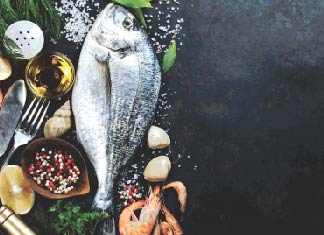Bounty of the sea: Premium exports of seafood in the Pacific
- Caifu Magazine | by Caifu Global
- EN

By Alan Forsythe
In the search for new business ventures and new exports, we often overlook the traditional. Fishing, one of the oldest industries in the history of civilization is of course alive and well, with 2014 sales of seafood in North America reaching close to $16 billion (seafoodsource.com).
For British Columbia seafood exports for 2013 are up 17 percent. And while the U.S remains the number one destination for most B.C seafood with exports totaling $514 million, Asian destinations are making up most of the growth, especially China, which has overtaken the U.S as the number one consumers of seafood. The next four largest export markets for B.C seafood are China ($179 million) Japan ($108 million) Hong Kong ($31 million) and Vietnam ($18 million), total numbers for 2014 are expected to top $1 billion. In comparison to other global competitors Canada was the sixth largest supplier of seafood to Chinese markets in 2013 (behind Russia, United States, Peru, Chile and Norway).
However increasingly it’s an industry of specialization, and despite the numbers most producers remain small operations, with many still family-owned, either selling direct to wholesalers on the docks or wholesaling their catch.
Seafood is a premium product throughout Asia, North America and Europe and with per item costs comes certain demands and expectations. The very fact that Vietnam is an export market for B.C seafood demonstrates the high demand for quality seafood products to Asian markets.
As Teresa Wat, Minister for International Trade & Minister responsible for Asia & Pacific Strategy explains Chinese consumers are increasingly looking outside of China for product and Canada in general is very trusted as an exporter, and B.C in particular has traditionally had strong ties to the Asia/Pacific region.
“A decade ago we were very dependent on the U.S market, but we’ve come to realize we can’t depend on one export market,” said Wat, who has been on trade missions throughout Asia.
The upcoming Trans-Pacific Trade Partnership (TPP) will also lower tariffs in key markets and further help B.C/Canadian exports. In advance of that agreement Canada last year signed the Canada-Korea Free Trade Agreement (CKFT) dramatically lowering tariffs for Canadian exports to South Korea. Wat says with the new trade agreements she expects South Korea to become a significant export market for B.C. seafood.
Salmon, especially Sockeye, will of course continue to be the most high value export product. The salmon fishery in recent decades was in danger of collapsing, but strict conservation policies in the late 1990s has seen fish stocks return to sustainable levels.
It has also benefitted (one could argue) from the creation of the B.C Seafood Alliance in 1999, which helps to self-police the industry so that harvests remain at self-sustaining levels, and as Wat notes, helps maintains B.C’s reputation as a quality exporter.
One indicator of a healthy fishery is the presence of herring. Not only have herring returned to coastal and inlet areas of B.C’s south coast, they have returned in near record numbers. Furthermore their value has increased, as herring roe (rich in those essential Omega 3 fatty acids) has risen in demand, largely due to the Japanese market where Kazunoko (herring roe) is considered a delicacy.
The Japanese market (as well as the Chinese market) also has a high demand for Pacific crab, shrimp, tuna, hake (a ground fish) and goeduck (pronounced gooey-duck).
For those unfamiliar with this oversized shellfish, goeduck is native to the Pacific Northwest (B.C, Washington State). It is a burrowing clam and therefore difficult to harvest, but scarcity of course breeds value and goeduck can reach prices $175/lb ($390/kg) in China and Japan.
An unexpected growth industry in B.C seafood has been aquaculture in the form of sea cucumber and seaweed. Although still relatively small, seaweed harvesting alone realized $7.5 million on the wholesale market for B.C industry in 2014 (from a combination of cultivated and wild sources).
Although sometimes criticized by traditional local fisheries, farmed salmon is also increasingly meeting the demand for that fishery on the Asian market.
“In the West we tend to prefer wild salmon because there’s a general misconception that wild salmon is better,” said Wat, “in Asia that is much less so, they don’t see a big difference between the two.”
That would appear to be true, as Norway has a much larger farmed fishing industry that successfully exports all over the world. They, like Canada’s Maritime provinces have the advantage that Atlantic seafood is generally perceived to be superior to Pacific fisheries (with lobster the perennial number one premium seafood product).
Fish farming is of course practiced in Asia as well, although as Wat notes, it is primarily done in self-contained land-based fisheries, not in enclosed coastal waters as is largely the practice in B.C. That may be changing though with the opening of the aboriginal-owned land-based KUTERRA fish farm on Vancouver Island, which is specializing in Atlantic salmon. It is a small operation but certainly a big first step towards proof of concept. Some have even speculated that in the not too distant future Canada may even begin exporting Atlantic salmon produced on fish farms on the prairie-provinces where land is plentiful.
In the meantime with the Asian market export market expanding B.C salmon of all species, Pink, Coho, Chinook, Spring and the aforementioned sockeye, farmed or wild, along with halibut can only expect to see increased demand.
However what of B.C/Canadian seafood imports? Canadians, especially Westcoast residents can be almost as selective in their seafood as their Asian counterparts. Sea bass continues to be a premium seafood product, originally supplied by South American fisheries, but more and more now coming from Southeast Asia. Shellfish, especially oysters are a delicacy in Canada, and the most premium varieties (outside of the Atlantic) come from Japan, along with many varieties of shrimp and prawns. Tuna, always in high demand, is increasingly imported from Southeast Asian fisheries, along with the Basa fish (mainly Vietnam and Indonesia).
Canada is also the second largest importer of Chinese seafood (second only to the U.S) mostly in the form of frozen, processed seafood.
China, like Japan, is becoming one of the leaders in the world in developing inland fish farms, and while the vast majority of Chinese seafood production is for domestic consumption, it is not inconceivable that they, along with Japan, could become a leading source of tuna, as those stocks dwindle in the wild.















